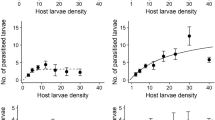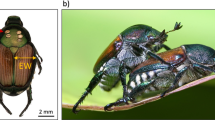Abstract
We studied the effect of Trichogramma brassicae Bezdenko (Hymenoptera: Trichogrammatidae) parasitism of Tuta absoluta Meyrick (Lepidoptera: Gelechiidae) eggs on the foraging behavior of Nabis pseudoferus Remane (Hemiptera: Nabidae) feeding on T. absoluta eggs of different ages. Older parasitized eggs (48–72 h old) were rejected after probing with the probosis. A separate experiment showed that probing did not harm developing parasitoids. Bugs greatly reduced their feeding times on older parasitized eggs and spent more time grooming and probing eggs and leaves. Predators exhibited a type III functional response to 24 h-old eggs, but a type II response to older eggs, whether parasitized or not. 24 h-old eggs suffered higher attack rates, and required less handling time than older eggs. Although the predatory efficiency of N. pseudoferus was reduced in the presence of parasitized eggs, the partial refuge enjoyed by T. brassicae in older eggs may permit an additive impact on the pest, and should facilitate the joint augmentation of both species against T. absoluta.


Similar content being viewed by others
References
Arim M, Marquet PA (2004) Intraguild predation: a widespread interaction related to species biology. Ecol Lett 7:557–564
Braham M, Hajji L (2012) Management of Tuta absoluta (Lepidoptera, Gelechiidae) with insecticides on tomatoes. IntechOpen. http://cdn.intechopen.com/pdfs/28268/InTech-Management_of_tuta_absoluta_lepidoptera_gelechiidae_with_insecticides_on_tomatoes.pdf. Accessed 18 Dec 2019
Brodeur J, Rosenheim JA (2000) Intraguild interactions in aphid parasitoids. Entomol Exp Appl 97:93–108
Cabello T, Gallego JR, Fernández-Maldonado FJ, Soler A, Beltrán D, Parra A, Vila E (2009) The damsel bug Nabis pseudoferus (Hem.: Nabidae) as a new biological control agent of the South American Tomato Pinworm, Tuta absoluta (Lep.: Gelechiidae), in tomato crops of Spain. IOBC/WPRS Bull 49:219–223
Cabello T, Bonfil F, Gallego JR, Fernandez FJ, Gamez M, Garay J (2015) Can interactions between an omnivorous hemipteran and an egg parasitoid limit the level of biological control for the tomato pinworm? Environ Entomol 44:12–26
Cheraghi A, Shishehbor P, Kocheili F, Rasekh A, Jamshidnia A (2018) Effects of egg age in Sesamia cretica (Lepidoptera: Noctuidae) on parasitism, development and reproduction of Telenomus busseolae (Hymenoptera: Platygastridae). J Crop Prot 7:125–133
Colfer R, Rosenheim JA (2001) Predation on immature parasitoids and its impact on aphid suppression. Oecologia 126:292–304
Costa A, Reeves JD (2011) Olfactory experience modifies semiochemical responses in a bark beetle predator. J Chem Ecol 37:1166–1176
Desneux N, Wajnberg E, Wyckhuys KA, Burgio G, Arpaia S, Narváez-Vasquez CA, González-Cabrera J, Ruescas DC, Tabone E, Frandon J (2010) Biological invasion of European tomato crops by Tuta absoluta: Ecology, geographic expansion and prospects for biological control. J Pest Sci 83:197–215
Garay J, Varga Z, Mori TF, Lopez I, Gamez M, Gallego JR, Cabello T (2018) Opportunistic random searcher versus intentional search image user. Sci Rep 8:3336
Hassell MP (1978) The dynamics of arthropod predator-prey systems. Princeton University Press, Princeton
Hoelmer K, Osborne L, Yokomi R (1994) Interactions of the whitefly predator Delphastus pusillus (Coleoptera: Coccinellidae) with parasitized sweetpotato whitefly (Homoptera: Aleyrodidae). Environ Entomol 23:136–139
Holling CS (1965) The functional response of predators to prey density and its role in mimicry and population regulation. Mem Entomol Soc Can 45:1–60
Iranipour S, Farazmand A, Saber M, Mashhadi JM (2009) Demography and life history of the egg parasitoid, Trichogramma brassicae, on two moths Anagasta kuehniella and Plodia interpunctella in the laboratory. J Insect Sci 9:51
Janssen A, Sabelis MW, Magalhães S, Montserrat M, van der Hammen T (2007) Habitat structure affects intraguild predation. Ecology 88(11):2713–2719
Juliano SA (2001) Nonlinear curve fitting: predation and functional response curves. In: Scheiner SM, Gurevitch J (eds) Design and analysis of ecological experiments. Oxford University Press, New York, pp 178–196
Kester KM, Jackson DM (1996) When good bugs go bad: intraguild predation by Jalysus wickhami on the parasitoid Cotesia congregata. Entomol Exp Appl 81:271–276
Mansfield S (2019) Intraguild predation and prey preferences influence biological control of Paropsis charybdis by the southern ladybird, Cleobora mellyi. Biol Control 129:164–170
Miura K, Kobayashi M (1998) Effects of host-egg age on the parasitism by Trichogramma chilonis Ishii (Hymenoptera: Trichogrammatidae), an egg parasitoid of the diamondback moth. Appl Entomol Zool 33:219–222
Mohammadpour M, Hosseini M, Karimi J, Hosseininevah V (2019) Effect of age-dependent parasitism in eggs of Tuta absoluta (Lepidoptera: Gelechiidae) on intraguild predation between Nabis pseudoferus (Hemiptera: Nabidae) and Trichogramma brassicae (Hymenoptera: Trichogrammatidae). J Insect Sci 19(3):27
Mullins CB, Giles KL, Royer TA (2013) Impact of Lysiphlebus testaceipes stage of development within greenbug hosts on survival and development of late-stage Hippodamia convergens larvae. Southwest Entomol 38:549–559
Nguyen QH (2008) Circadian rhythms and effects of different diets on the development and reproduction of Nabis kinbergii (Hemipteria: Nabidae). M.Sc. Thesis, University of Adelaide, School of Agriculture, Food and Wine
Oaten A, Murdoch WW (1975) Switching, functional response, and stability in predator-prey systems. Am Nat 109:299–318
Pell JK, Baverstock J, Roy HE, Ware RL, Majerus ME (2008) Intraguild predation involving Harmonia axyridis: a review of current knowledge and future perspectives. BioControl 53:147–168
Polaszek A, Rugman-Jones PF, Stouthamer R, Hernandez-Suarez E, Cabello T, del Pino PM (2012) Molecular and morphological diagnoses of five species of Trichogramma: biological control agents of Chrysodeixis chalcites (Lepidoptera: Noctuidae) and Tuta absoluta (Lepidoptera: Gelechiidae) in the Canary Islands. BioControl 57:21–35
Polis GA, Myers CA, Holt RD (1989) The ecology and evolution of intraguild predation: potential competitors that eat each other. Annu Rev Ecol Syst 20:297–330
Pritchard DW, Paterson RA, Bovy HC, Barrios-O’Neill D (2017) frair: an R package for fitting and comparing consumer functional responses. Methods Ecol Evol 8:1528–1534
R Core Team (2020) R: a language and environment for statistical computing. R Foundation for Statistical Computing, Vienna. https://www.r-project.org/
Roger C, Coderre D, Vigneault C, Boivin G (2001) Prey discrimination by a generalist coccinellid predator: effect of prey age or parasitism? Ecol Entomol 26:163–172
Rogers D (1972) Random search and insect population models. J Anim Ecol 41:369–383
Rosenheim JA, Kaya HK, Ehler LE, Marois JJ, Jaffee BA (1995) Intraguild predation among biological control agents: theory and evidence. Biol Control 5:303–335
Royer TA, Giles KL, Lebusa MM, Payton ME (2008) Preference and suitability of greenbugs, Schizaphis graminum (Hemiptera: Aphididae) mummies parasitized by Lysiphlebus testaceipes as food for Coccinella septempunctata and Hippodamia convergens (Coleoptera: Coccinellidae). Biol Control 47:82–88
Samara RY, Monje JC, Qubbaj TA, Zebitz CPW (2011) Host age preference behaviour of Trichogramma aurosum Sugonjaev & Sorokina (Hymenoptera: Trichogrammatidae). Int J Agron Plant Prod 2:57–68
Schenk D, Bacher S (2002) Functional response of a generalist insect predator to one of its prey species in the field. J Anim Ecol 71:524–531
Snyder WE, Ives AR (2001) Generalist predators disrupt biological control by a specialist parasitoid. Ecology 82:705–716
Sohrabi F, Enkegaard A, Shishehbor P, Saber M, Mosaddegh MS (2013) Intraguild predation by the generalist predator Orius majusculus on the parasitoid Encarsia formosa. BioControl 58:65–72
Stasek DJ, Radl JN, Crist TO (2018) The functional response and prey preference of generalist Nabis (Hemiptera: Nabidae) predators to leafhopper prey (Hemiptera: Cicadellidae). Can Entomol 150:190–200
StatSoft (2016) Statistica ver. 13.2. Tibco Data Science. http://www.tibco.com/
Tormos J, Beitia F, Asís J, de Pedro L (2018) Intraguild interactions between two biological control agents in citrus fruit: implications for biological control of medfly. Ann Appl Biol 172:321–331
Zhou Y, Abram PK, Boivin G, Brodeur J (2014) Increasing host age does not have the expected negative effects on the fitness parameters of an egg parasitoid. Entomol Exp Appl 151:106–111
Acknowledgements
We thank the research deputy of the Ferdowsi University of Mashhad for Grant No (3/45035) which financially supported this research.
Author information
Authors and Affiliations
Corresponding author
Ethics declarations
Conflict of interest
The authors declare this to be an original research project comprising part of the PhD thesis requirements of MM under supervision of MH at the Ferdowsi University of Mashhad. We have no conflicts of interest to declare and can confirm that this work is not under consideration for publication in any other journal.
Additional information
Handling Editor: Marta Montserrat.
Rights and permissions
About this article
Cite this article
Mohammadpour, M., Michaud, J.P., Hosseini, M. et al. Age and parasitism status of Tuta absoluta eggs alter the foraging responses of the predator Nabis pseudoferus. BioControl 66, 395–406 (2021). https://doi.org/10.1007/s10526-021-10078-7
Received:
Accepted:
Published:
Issue Date:
DOI: https://doi.org/10.1007/s10526-021-10078-7




